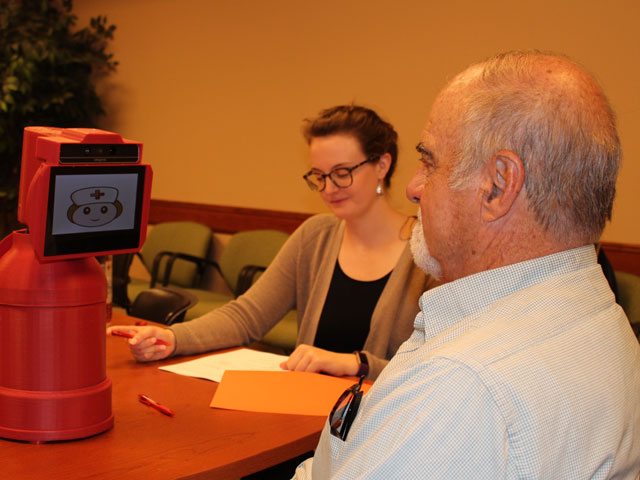
Dr. Weihua Sheng leads a team of researchers developing robotic healthcare aides for older adults
Monday, January 10, 2022
Media Contact: Kristi Wheeler | Manager, CEAT Marketing and Communications | 405-744-5831 | kristi.wheeler@okstate.edu
The idea of having a home-based healthcare robot may not be one of futuristic fantasy, according to a team of researchers from across Oklahoma who are developing technology that could be the future of healthcare for geriatric individuals.
Dr. Weihua Sheng — from the School of Electrical and Computer Engineering in the College of Engineering, Architecture and Technology at Oklahoma State University — leads the team in its development of a robot that can aid in the expansion of healthcare services to geriatric individuals that either live at home or in a geriatric care community.
The team is comprised of researchers from the areas of engineering, human sciences and psychology at OSU, as well as members from the University of Oklahoma’s College of Nursing.
“This is a truly interdisciplinary endeavor,” said Dr. Alex Bishop, an associate professor and Brian Close Professor in Adulthood and Aging from OSU’s Department of Human Development and Family Science. “I don’t see how we could complete this project without looking through the different lenses of our team members.”
Sheng’s focus has always been on robotics and he brought his research to OSU in 2006. The idea for Elsa, the geriatric assistance robot, was born from a recognition of challenges faced by geriatric populations, including health monitoring and intervention, as well as mental and psychological needs.
Also, the team has identified a new challenge that, while not exclusive to Oklahoma, is certainly prevalent within the state — the need for attentive healthcare in rural environments. Populations that are geographically isolated from larger metropolitan areas might pose a unique challenge to healthcare workers.
Elsa was designed to address a number of growing challenges. The unit is capable of interacting with its patient through both audio and visual interfaces, each providing unique benefits to missions such as reminding a patient to take medication, monitoring the patient for any abnormal behavior, or providing interactive entertainment, such as playing rock, paper, scissors.

The project has received funding from the National Science Foundation through several grants, most recently focused on the collection and use of sound data by Elsa as a means to trigger action or intervention from the unit. For instance, if Elsa collects sound data and creates a baseline of “normal” sounds, then it could, in theory, recognize an abnormality, such as a fall, and be able to intervene and contact someone for assistance.
Elsa can also administer routine mental and physical check-ups. Through a series of questions and data collection, the unit can determine whether the patient is in good mental and physical health or if they require assistance or further examination from a healthcare professional.
However, each of the tasks and services that Elsa offers come with its own set of unique challenges, which come in the form of technical, psychological and in some cases, legal issues that must be identified and overcome. Overcoming these challenges will dictate the next steps taken in the teams’ development process.
Technical challenges include the actual collection of sound and video data. While technology exists that can collect the data, Sheng says that those means of collection are simplistic and must be refined in order to meet the rigorous requirements that a home healthcare robot will face.
“The unit must be able to learn and adapt to numerous possible situations,” Sheng said. “The robot must be able to understand the context and intricacies of human interaction in order to accurately interpret the data it collects.”
Whereas a person might be able to understand the context of a minutely delayed response to a memory-based question, a robot will collect the audio data and strictly apply a given set of rules in order to determine if the response meets the requirements and can then be deemed as acceptable or not.
Also, the question of legality, as it pertains to active monitoring of an individual through either video or audio, is one that current iterations of in-home aid devices face today. The question of “Does this method of data collection cross the line of invasion of privacy?” is one that will play a prominent role in any interactive audio or visual device that an individual brings into their home.
Lastly, the team has identified the challenge of adoption of the technology by individuals as a key factor in the future success of these types of devices. The future of this in-home healthcare device will be dependent upon whether an individual will be able to trust a robot to provide accurate and dependable healthcare. As technology becomes more integral to day-to-day life, the more likely it will become that a device will one day be acceptable and welcomed into an individual’s home and life.
However, the adoption of Elsa isn’t just a patient problem, but a challenge from the healthcare provider’s perspective as well. In late 2020, the team administered focus group research amongst health care workers from around the state of Oklahoma to determine what specifications professionals felt a home-based healthcare robot would need to meet in order to be useful. The researchers found that the most meaningful features were things that they had already begun working on: communication and intervention.The healthcare professionals in the focus groups attested that communication, both with the patient and the healthcare provider, was paramount to the utility and effectiveness of a robot like Elsa. The ability for Elsa to have constant communication with a patient, when a healthcare professional can’t, and then relay that information to the healthcare provider would be an amazing tool in the home-health industry.
Story by: Jeff Hopper | IMPACT Magazine
